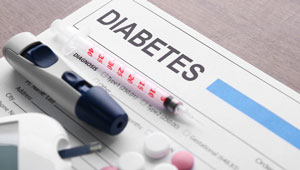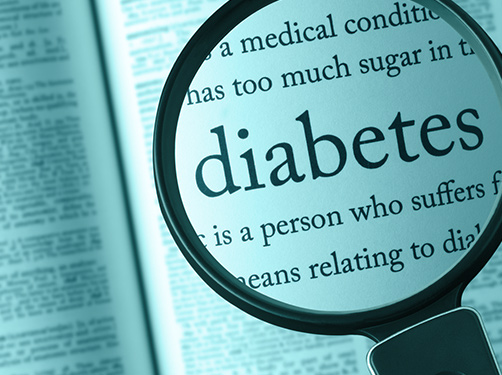What is type 2 diabetes?
Scientific support: Dr. Theresia Sarabhai
Type 2 diabetes is a chronic metabolic disorder. Various processes in the sugar metabolism are disturbed in this disease, leading to a permanent increase in blood sugar levels. Type 2 diabetes is often simply referred to as “sugar disease” in German.
It is the most common form of diabetes and typically occurs in older individuals. This is why type 2 diabetes was also known as “age-related diabetes" or “adult-onset diabetes.” However, in recent years, younger individuals are increasingly being diagnosed with type 2 diabetes.

After a meal, blood sugar levels rise. The sugar (glucose) present in the food serves as an energy source for the body cells. In order to be able to absorb sugar into the body's cells, the body needs the hormone insulin. Insulin is produced in the beta cells of the pancreas and is released into the blood depending on the blood sugar level. It binds to the body cells, facilitating the absorption of sugar, thereby reducing blood sugar levels.
However, in type 2 diabetes, body cells become less sensitive to the released insulin, meaning they are insulin-resistant. In addition, the insulin-producing beta cells of the pancreas release insufficient insulin. As a result, blood sugar levels increase.
Further information about the development of type 2 diabetes can be found here.
Contents
1. What are the symptoms of type 2 diabetes?
Type 2 diabetes often develops gradually over several years. Individuals affected often experience no or only nonspecific symptoms. As a result, the disease remains unknown for a large portion of people with type 2 diabetes for a long time. Diagnosis frequently occurs due to diabetes-related secondary diseases or by chance, such as during a routine health check with a general practitioner.
However, with very high blood sugar levels, diabetes-specific symptoms can also occur in people with type 2 diabetes.
Possible symptoms of type 2 diabetes include:
- Increased thirst
- Frequent urination
- Fatigue
- Feeling of weakness
- Lack of drive
- Poor performance or concentration
- Forgetfulness
- Low mood through to depression
- Visual impairment
- Frequent infections
- Poor wound healing
- Dry skin
2. What are the consequences of consistently elevated blood sugar levels?
If type 2 diabetes goes unrecognized and blood sugar remains consistently high for an extended period, the disease can progress and contribute to the development of further complications, known as diabetes-related secondary diseases. Therefore, early diagnosis and treatment of diabetes are important to prevent possible secondary diseases or at least delay their progression.
This is because consistently elevated blood sugar levels favor the long-term development of
- nerve damage, which can, for example, contribute to the development of diabetic foot syndrome.
- Changes to the large blood vessels which can result in serious complications (heart attack, stroke or impaired blood circulation to the legs).
- Damage to the small blood vessels. This can lead to damage in the heart, eyes and/or kidneys.
Further information on possible diabetes-related complications can be found here.
If blood sugar levels remain high for an extended period, it can lead to hyperglycemia. In type 2 diabetes, a condition called hyperglycemic hyperosmolar syndrome can develop, potentially leading to a coma. This is considered an acute emergency situation.
You can find more information about hyperglycemia and hyperglycemic hyperosmolar syndrome here.
3. Who gets type 2 diabetes?
While type 1 diabetes is an autoimmune disease, an unhealthy lifestyle often contributes to the development of type 2 diabetes: a high-calorie, low-fiber diet, lack of physical activity, and being overweight — especially in the abdominal region — increase the risk of type 2 diabetes. However, genetic predisposition can also elevate the risk of developing the disease.
A comprehensive overview of the risk factors for type 2 diabetes can be found here.
Would you like to find out if you have an elevated risk of type 2 diabetes? The German Diabetes Risk Score can help adults determine their personal risk of developing type 2 diabetes within the next 10 years.
4. Subtypes of diabetes
Diabetes mellitus, specifically type 2 diabetes, is a very complex disease with individually different courses. Researchers have proposed a new classification into a total of 5 diabetes subtypes.
The diabetes subtypes differ in terms of their origin, course, and the risk of developing certain secondary diseases. This allows targeted prevention of secondary diseases and a therapy tailored to the respective subtype.
5. Is type 2 diabetes curable?
The basis of type 2 diabetes therapy is a lifestyle change towards a balanced diet and regular physical activity. Often, small changes are sufficient to lower blood sugar levels.
If the basic therapy alone is not sufficient to bring blood sugar into the normal range, additional blood sugar-lowering medications in tablet form, known as oral antidiabetic drugs or glucose-lowering agents, can be used. If type 2 diabetes is advanced, insulin therapy may be necessary.
Find out more about treatment options for type 2 diabetes here.
In some cases, blood sugar levels in people with type 2 diabetes can also normalize completely. A crucial factor seems to be weight loss and the long-term maintenance of weight. If the long-term blood sugar level (HbA1c) drops below 6.5 percent (48 mmol/mol) for at least 3 months without using blood sugar-lowering medications, experts consider it a remission of type 2 diabetes.
However, it is currently unclear whether remission can be achieved permanently.
6. Prevention of type 2 diabetes
Type 2 diabetes does not occur suddenly, but rather develops gradually over years. In addition to genetics, an unhealthy lifestyle and the presence of excess weight, especially in the abdominal region, play a crucial role in the development of type 2 diabetes.
However, if an elevated risk of type 2 diabetes is detected early, the development of the disease can often be prevented or at least delayed. Often, small lifestyle changes are usually sufficient to alleviate the metabolism. These include, for example:
- A balanced and healthy diet
- Regular exercise
- Avoiding stress
- Abstaining from tobacco and alcohol
- If necessary, weight reduction
You can find a wide range of practical tips for everyday life on our "Preventing diabetes" portal.
Sources:
Ahlqvist, E. et al.: Novel subgroups of adult-onset diabetes and their association with outcomes: a data-driven cluster analysis of six variables. In: Lancet Diabetes Endocrinol, 2018, 6: 361-369
American Diabetes Association: 2. Classification and Diagnosis of Diabetes: Standards of Medical Care in Diabetes - 2023. In: Diabetes Care, 2023, 46: S19-S40
Bundesärztekammer et al.: Nationale Versorgungsleitlinie Typ-2-Diabetes. Langfassung. Version 3.0. 2023
Landgraf, R. et al.: Definition, Klassifikation, Diagnostik und Differenzialdiagnostik des Diabetes mellitus: Update 2022. In: Diabetologie, 2022, 17: S98-S110
Landgraf, R. et al.: Therapie des Typ-2-Diabetes. In Diabetologie, 2022, 17: S159-S204
Lean, M. E. J. et al.: Durability of a primary care-led weight-management intervention for remission of type 2 diabetes: 2-year results of the DiRECT open-label, cluster-randomised trial. In: Lancet Diabetes Endocrinol, 2019, 7: 344-355
Zaharia, O. P. et al.: Risk of diabetes-associated diseases in subgroups of patients with recent-onset diabetes: a 5-year follow-up study. In: Lancet Diabetes Endocrinol, 2019, 7: 684-694
As of: 28.12.2023





